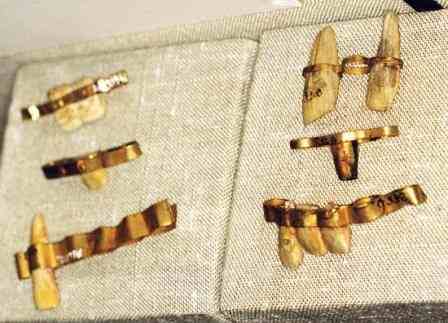False teeth were secured in the mouth
by gold bridgework with a metal pin and fitted on to the remaining teeth. All found
examples are made with bands, without any palate and resemble the “bridge work”
of these days. Some of the found examples were completely
hollowed out. They appear as if they had been prepared to crown broken teeth or
roots.
The most of the resources talk about Etruscans in northern Italy who made first false teeth around 700 BC. Dentures were made out of human or animal teeth, mostly out of ox teeth. Some dentures were fixed permanently and some could be pulled out to be cleaned. It was very advanced if we compare this technology to the technology of 16th century dentures.
Below is part of science text about founding on one Etruscan scull:
“It is evident that one of the bicuspids had been lost Below is part of science text about founding on one Etruscan scull:
during the life of the individual, for some time before
the denture had been made. The space had closed up.
The denture is of very excellent gold; it is probably
nearly pure in quality, rather thick, and made
strongly; the workmanship is very good, and the plate
has been carefully and nicely finished; no file marks
are apparent: all is smooth and artistically done.
The rings or bands are joined by solder, a solder so
good that its color, even after it has been under ground
for so many centuries, probably twenty five or thirty,
is equal to that of the other parts of the plate. — Even
with a good lens it is impossible to detect any difference
of color, or any flaw of any description.”
(FLORENCE: PRINTED BY G. BARBERA. VIA PAENZA, 60. UNIVERSITY OF CALIFORNIA LIBRARY)
Dentures were only an option for the wealthy as they were expensive to make and there were no specialist dentists so dentistry was one of the duties of a physician.
Around the world history of dentistry
The history of artificial tooth replacement goes all the way back to 2500BC. These were found in Mexico and consisted of what experts believe to be wolf teeth.
One recourse mentioned third century BC when teeth were cut out of ivory and fastened with a gold wire to rich Phoenicians.
„Egypt
Archeological evidence suggests that the ancient Egyptians were using their own medical technology to create primitive forms of early dentures by around the year 1500 B.C. They took human teeth and threaded them with gold wire to produce a functioning set of false teeth to replace missing teeth.
Mexico
While not using wire or other materials to hold together teeth, the ancient tribes of Mexico would replace damaged or lost teeth with the teeth of animals, most likely wolves. Although archeologists don’t understand the exact process the ancient tribes used, it’s most likely they would simply insert the animal teeth into the empty sockets along the gum line that used to hold the lost teeth.
Japan
Japan is known for producing history’s oldest known pair of complete dentures, which was a set of wooden teeth that historians trace back to the Ganjyoji Temple in Kii Province. Made from a species of tree commonly referred to as Japanese Box, or Buxus microphylla, these early teeth were believed to be used by the priestess, Nakaoka Tei. The dentures had almost the same shape as modern dentures, and attached inside the mouth with suction. The Japanese continued to utilize wooden dentures as the primary form of tooth replacement until the Meiji era of the late 19th century.
Italy
The practice of using animal teeth was one that has endured throughout history. By 700 B.C., the Etruscans of Italy were using gold wire to bind human and animal teeth together in order to act as a replacement set of teeth. Although these early forms of dentures fell apart easily, they were easy to produce, repair and replace. This early practice of binding human and animal teeth together with wire would remain the standard in Europe until the Renaissance of the mid-1800’s.
Mayan Civilization
Before dental implants, early civilizations attempted to replace missing teeth with rock or bones. Modern dental implants did not emerge until the rise of technology; however, the concept has been with us for hundreds, if not thousands of years. According to archaeologists, the ancient Mayans experimented with tooth replacements around 600 A.D. by placing carved stones, seashells fragments and bits of bone into the empty cavity where the teeth used to be. Evidence suggests that these primitive methods worked well, because the materials actually fused with the jawbone permanently. “
Cited from:
www.glebedental.com.au
Funny side of history about teeth
In the fifth century BC, Hippocrates recommended the use of ash tree mice and a rabbit’s head to save healthy teeth and to remove fetid odors from the mouth.
Healer Pliny recommended for the prevention of dental diseases eating a fried mouse once every two months. His other idea to have stronger teeth was to attach frog to the jaw. If you would put few drops of olive oil (in which prior to use were fried worms) in to your ears it would stop tooth ache.
In China it was recommended to brush teeth with the burned head of monkey ashes. (Officially in use were toothbrushes made from animal bristles. Toothpaste ingredients often included salt as a mild abrasive mixed with sweetening and antibacterial ingredients like mint and ginseng.)
Ancient Romans, for hygienic procedures, prepared pearl or coral powder.
Egyptians would put a mouse on aching tooth because mouse has such a good teeth. :)
I would stick with regular toothpaste ;)

No comments:
Post a Comment